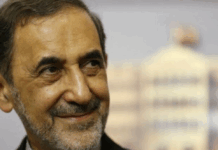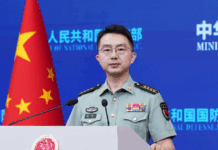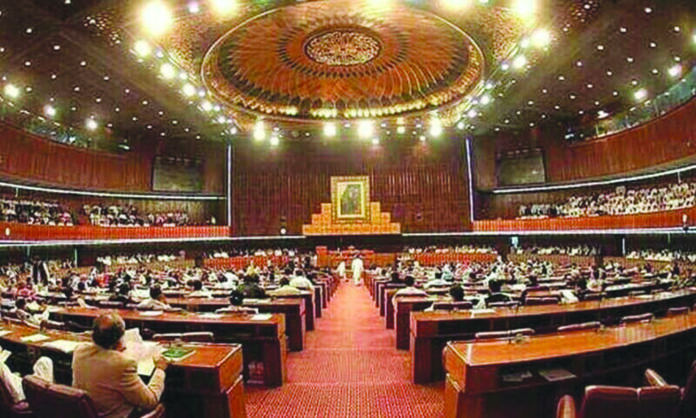AT PENPOINT
The purpose of the passage of the 26th Amendment will become obvious when the government manages to obtain what it had meant by its introduction. But at the moment it will take away two positives.
First, that the Amendment was passed at all. The failure to pass it on the first attempt last month was a huge embarrassment for the government, and to fail again might well have been fatal for it. Second, it was passed without any use of the wriggle-room created by the recent Supreme Court decision rolling back the earlier verdict on those voting so as to fall in the mischief of Article 63A; in short, it allowed votes against the party chief’s instructions to be counted rather than discarded. It opened a crack for floor-crossing, and even though five MNAs broke away from the PTI to sit on the Treasury benches even though elected as PTI-backed independents, there were no wholesale crossings from the PTI to get the amendment passed, even thought there was enough leeway in their status for them to make the switch. Of course, members would decide on their estimate of what would happen to them at the next general election.
It should be noted that originally, it was the refusal of the JUI(F) which led to the collapse of the first attempt. As it is, the JUI(F) proved crucial to passing the Amendment, and it is now for the government to reckon up the balance between what it had let go, and what it had conceded, to work out whether it has made a good bargain.
Perhaps the touchstone of whether it made a good bargain will be whether it can do what the PML(N) planned to do. That will be seen in the days and weeks to come, but the original intention of getting the present Chief Justice of Pakistan to head a new constitutional court had been abandoned, and instead of a separate court, a Constitutional Bench of the Supreme Court is to be set up. That means the present CJP will retire on the due date, which is by the end of the month. That Bench will have a head, it will have its own rules, but the position of the Chief Justice has not been compromised as the head of the judiciary, as the head of the Constitutional Bench will remain a judge under him, provided he is not on it himself.
The drafting of the Amendment appears to have been done to avert the invocation of the Basic Structures Doctrine, The mechanism approved of in verdict of the 2010 writ petitions, and in which the Court hinted that the 19th Amendment could be struck down if it did not conform to the Basic Structure of the Constitution, which included independence of judiciary. That seems to be why the Judicial Commission. The appointment of the Chief Justice of Pakistan has been given to Parliament. Executive interference has been resented, everywhere and all the time, and from a process in which the executive, in the shape of the Prime Minister, decided, we have the mechanism of the Judicial Commission, which means the Chief Justice and senior justices decide, and the Prime Minister and President just sign off. Now the Judicial Commission has been expanded to include legislators and a nominee of the National Assembly Speaker.
The 26th Amendment has yielded the government victory in battles, but do they represent improvement in the longer run? That is something that time will tell.
The judiciary seems to have been blindsided here, because while there is a very strong impulse for the separation of the judiciary and the executive, there seems to be no injunction about separating the executive from the legislature.
One of the first things that has happened is that the new Chief Justice, Mr Justice Yahya Afridi, provides an object lesson in how the new system works. He would have had a 13-month term as CJP under the previous principle of going by seniority, because he would have retired in 20230, but instead, he has taken over the tenures of Mr Justice Mansoor Ali Shah and Mr Justice Munib Akhtar, who have now been superseded.
Incidentally, one of the principles thrown by the wayside by the 26th has been that of ‘legitimate expectancy’, which established seniority as the rule for becoming Chief Justice, or being elevated from a High Court to the Supreme Court. It implied that anyone selected to be high court judge was also capable of being a CJP. Has it been thrown away entirely, or does it remain for elevations to the Supreme Court?
Operationalizing the Judicial Commission will also be problematic in the absence of the head of the Constitutional Benches, who in turn cannot be appointed except by the Commission. How the first appointment is made will lead to litigation, as will the 26th itself. The PTI is increasing the arguments on the Basic Structure Doctrine. There seems no intent to mount a challenge on the ground that it was not properly passed. There is the ancillary argument that the National Assembly, being based on false election results, was not competent to amend the Constitution. There is the additional argument that without the women’s seats having been filled, the Amendment could not have been made by the House. It has also been stated that the PTI will challenge the 26th before the Supreme Court as headed by Mr Justice Afridi.
M Justice Afridi’s appointment means no CJP will be appointed for three years, rather than the procession of CJPs under the seniority rule. Mr Justice Shah should have succeeded now, to be followed by Mr Justice Munib and then Mr Justice Afridi. Mr Justice Afridi would have then handed over to Ms Justice Ayesha Malik, who would in turn have handed after a tenure of few months to Mr Justice Shahid Wheed. After that, the CJP would be someone probably presently on one of the high courts, but not yet elevated to the Supreme Court.
However, now when Mr Justice Afridi retires, Mr Justice Muhammad Ali Mazhar, Ms Justice Ayesha Malik and Mr Justice Shahid Waheed would be the three senior most judges. It may be seen that Mr Justice Mazhar would suddenly be in with a chance, which under the old dispensation did not exist.
It is interesting that the maximum tenure of a Chief Justice has been fixed at three years. It is doubly interesting that that seems to be the tenure of a Prime Minister since 1985, because the president dissolved the Assembly around them. When that was ended, Mian Nawaz Sharif was removed by a military coup. Since the restoration of elections in 2003. The PM first elected by Parliament has been removed from office after around three years, whether by resignation, disqualification or a vote of no-confidence. Someone has filled in for the rest of the term, but apart from Mian Shehbaz Sharif no one has been elected to a second term.
It is worth noting that the service chiefs have a three-year tenure. It is worth noting that while the Navy and PAF chiefs have had three-year tenures without exception since 1986, the previous two Army chiefs received an extension that amounted to a second term.
The 26th Amendment has yielded the government victory in battles, but do they represent improvement in the longer run? That is something that time will tell.






















